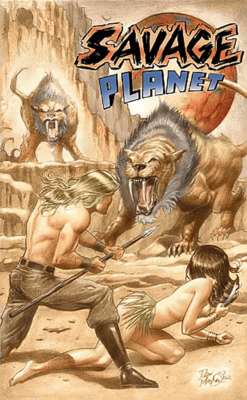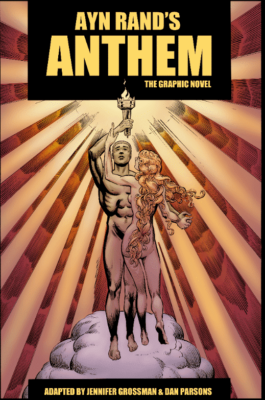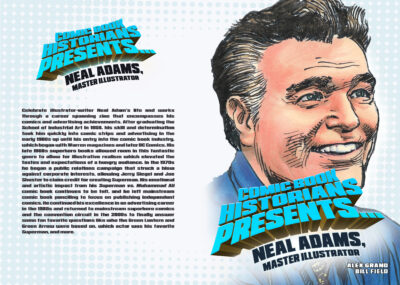Dan Parsons Interview, Fantasy Comic Artist by Alex Grand & Bill Field
Check out Alex Grand & Bill Field’s biographical zine on Neal Adams in Comic Book Historians presents… Neal Adams, Master Illustrator!
meanwhile enjoy the show…
Dan Parsons Interview found at 00:36 of CBH podcast episode above:
Bill Field: Here we are with one of our favorites, that’s Dan Parsons. Dan’s known for his long career at DC as well as his wonderful career doing Star Wars Comics for the last millennia. Dan, how is it going buddy?
Dan: It’s going pretty good. I finally made it through the crowds and got to my table.
Bill: Fantastic. We’re joined of course by my cohort in crime, Alex Grand. Alex, do you have a few things you want to ask Dan?
Alex Grand: Dan, I’ve been a big fan for a while and I remember we met last year. I want to talk a little bit about your Star Wars career. You’ve done a lot of pages, you’ve done over 150 issues you said. Tell me how you got into Star Wars.
Dan: I was here back in 2002 when I was promoting my self-published book, Savage Planet.

Dan: It happened that Jan Duursema was sitting down the way from me, and she had recently lost her anchor on the book. She came down and looked at my work and could see that it was highly influenced by Al Williamson, who was one of the very first Star Wars artists that there are, and so she had me do a sample basically.
Dan: She contacted the Dark Horse people and had me try off for it and I got the job. That was back in 2002 like I said. I worked on the Star Wars books almost every Star Wars title they had over there. Then finally finished up when they lost the license back in 2014.

Alex: You were talking about Al Williamson. What was some of the favorite Al Williamson comics that you’ve read?
Dan: I liked his earlier stuff to some extent, like Weird Science Fantasy. Other stuff maybe when Frazetta was working with him. That was highly influential to me and even now going back I look at his style and it looks really close to mine. I even like some of the later stuff too, like when King Features relaunched Flash Gordon. He was pencil and inking that stuff and I think it’s great.
Dan: Of course his stuff was homage to Alex Raymond. I had actually been even into Alex Raymond before I was into Al Williamson, so it all became like a big circle and basically we’re all just carrying the torch for Alex Raymond.
Alex: That’s beautiful, so Alex Raymond’s Flash Gordon, do you feel like there is an artistic influence to the Al Williamson’s Star Wars and into the Star Wars work that you’ve done?
Dan: For sure. There’s no doubt about it. As a matter of fact, even George Lucas says that Star Wars to a great extent was a homage to Flash Gordon. For Al Williamson to work on Star Wars and then me to work on Star Wars for so long, it just has a logical training that’s been going since the 30s.
Alex: You’ve done inking and penciling. You can basically do it all, and you’ve told me that you’ve been influenced by Wally Wood as well with some of your inking. Can you explain some of that?
Dan: Yeah, Wally Wood I love his brushwork, his use of blacks. I particularly like him over Gill Kane in the late 60s. They worked together quite a bit for DC. Even some of his obscure stuff like this captain action toy comic, is one of my very favorites.

Dan: I have all those and I think they made a great team. But on his own also, I think Wally Wood had a great style.
Dan: Some of his figure work was a little stiff for me as a penciler. But I think just his use of black and white is probably in the top of all comic book creators throughout history really.
Alex: Have you ever gone over pencil pages of all the pages from all the artists and tried to ink them yourself?
Dan: No, I really haven’t. When I was a kid, they had that Marvel try out book, I don’t know if you remember that. I did ink a couple of John Romita pages. Other than that, no. I’d always just pencil or make my own stuff pretty much until Jan came to me and we talked about Williamson and Frazetta and the possibility of me inking her on the Star Wars stuff.
Alex: I know that you can illustrate pencil ink, but you can also cartoon. You’ve done some nice Archie type cartooning before. Who are some of your influences there?
Dan: As far as cartooning goes, I adapted to that because I was never really inspired by the cartoon art. I was always more realistic like Gill Kane, Alex Raymond, that type of thing. But I do have a degree in fine art and I have been able to adapt my style to whatever is needed. In addition to doing the Archie thing you mentioned, more recently I did the Avatar, the last air bender book, which took a little bit of a learning curve for me to learn to style.
Dan: But it’s all a matter of style and once you study something, you can understand the style. It’s just that personally, I tended to go for more of the realistic, physical, the anatomy type artist.
Alex: I know that you and I have spoken about Marie Severin before. She would just cartoon whatever style she was working on. Is that jarring to try to do that?
Dan: It takes somewhat of recalibration but I think that you can work outside of your own personal style or what you think you really love. It’s just a matter of getting somewhere where you understand that. I think with her in particular, I like her inking most of all also for that.
Bill: I’d like to close out by talking to you about something that I know is … someone that was a real hero to you and you’ve used quite a few of his characters and drawn Steve Ditko’s style. I was curious if you’d had any stories of Steve. If you ever met him?
Dan: It’s funny you should mention Steve Ditko because he is part of the Atlas Society, which is Ayn-Rand appreciation society. It was founded by her and it keeps her books going and I just did a book for them. It’s called Anthem. It basically adapts and runs 1937 science fiction book. I wanted to mention too, we were talking about Alex Raymond before. This book was written at ’37 and that was the peak of his period, so I really tried to key into that with the illustrations and the whole mood that I gave to the book.

Dan: It’s like almost continuing a perpetual tribute to Alex Raymond. I didn’t mean to neglect Steve Ditko. He’s a hard guy, I don’t know if you know that. He’s a recluse or was, until he died last week or whatever it was. I can say I do have a small connection to Ditko in that. On my second ink war world back in 2015, I won my second ink well for the Star Wars stuff, and he also won the hall of fame award, so that’s a small connection to him.
Bill: Thank you very much Dan.
Join us for more discussion at our Facebook group
check out our CBH documentary videos on our CBH Youtube Channel
get some historic comic book shirts, pillows, etc at CBH Merchandise
check out our CBH Podcast available on Apple Podcasts, Google PlayerFM and Stitcher.
Savage Planet ©Dan Parsons, Star Wars ©Disney, Captain Action©Captain Action Enterprises,Anthem ©Atlas Society, Images ©Their Respective Copyright Holders
Use of images are not intended to infringe on copyright, but merely used for academic purpose.
Interview © 2021 Comic Book Historians











